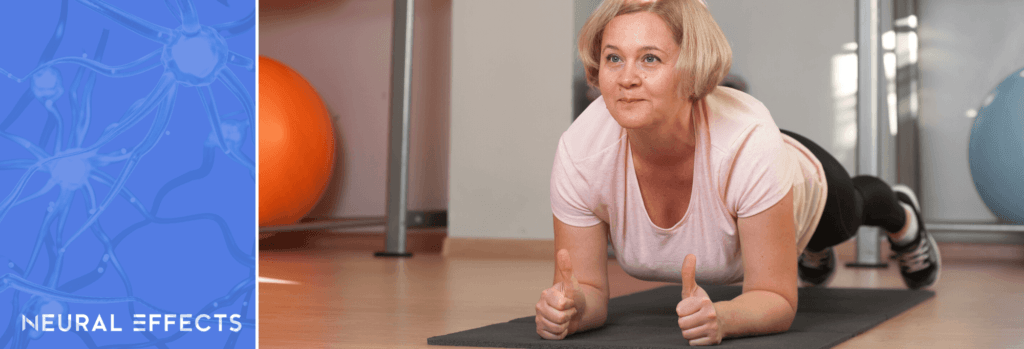Physical therapy exercises can be extremely beneficial for patients with dementia. Exercise not only improves cardiovascular health and fitness, but also improves mood, reduces anxiety, and slows down loss of cognitive function.
If you’re already undergoing regular sessions with a physical therapist, prioritize their instructions. Whether you’re looking for something to add to your routine or can’t afford physical therapy and need to exercise at home, you can use these exercises to improve your physical and mental fitness. Whatever your situation, we hope these exercises are helpful to you.
Physical and cognitive therapy are most effective together. At our clinic, Neural Effects, our team of health care professionals specializes in using a variety of physical and cognitive therapies to help slow down progression of the disease and promote independent living as long as possible.
Neural Effects uses the latest evidence-based techniques to diagnose and help dementia patients. We are located in Provo, Utah, and serve anyone in Salt Lake City or the Utah Valley area. We are in network for most types of medical insurance. Schedule your evaluation today.
How Does Physical Therapy Help Dementia Patients?

Physical therapy has many benefits for patients with Alzheimer’s disease, Lewy Body dementia, frontotemporal dementia, Parkinson’s disease, and other forms of dementia:
- Physical benefits: Not surprisingly, physical therapy benefits physical function and health. Exercise improves cardiovascular health (such as resting heart rate and blood pressure), increases fitness and strength, improves balance, and decreases the risk of falls. Patients carry out their daily activities more easily and enjoy improved quality of life.
- Cognitive benefits: Physical therapy can also slow down loss of cognitive function in dementia patients. This effect is likely due to increased blood flow to the brain, better sleep, improved cardiovascular health, and fewer symptoms associated with depression.
- Emotional benefits: Physical therapy helps with mental health problems, such as anxiety and depression, which are common amongst dementia patients. Engaging in regular exercise improves mood, reduces the need for medication, and helps the patient control emotional symptoms of dementia, such as restlessness, irritability, and aggression.
- Social benefits: In addition to physical, cognitive, and emotional benefits, physical therapy can offer dementia patients important social benefits. It reduces social anxiety, helps build stronger social connections, and supports dementia patients’ efforts to maintain their independence for longer.
Further reading: Physical therapy for dementia
In this article, we’ll look at some exercise training you can do at home. These exercises don’t require any special equipment and can be done anywhere. Many of them can be built into your weekly or daily routine. They include…
- Exercises to promote balance
- Exercises to help with grip strength
- Exercises for resistance training
- Yoga for dementia patients
- Exercises in the swimming pool
Exercises for Balance

Balance exercises train balance and motor skills. Balance training is especially important because it reduces the risk of falls and helps you maintain independence for longer. In addition, these exercises help the vestibular system, strengthen muscles associated with balance, improve cognitive function, and generally make activities of daily living easier to perform.
Any activity that involves walking and moving can help with balance. Below are a few targeted exercises to improve stability; if you aren’t sure which ones are safe or appropriate for you, please consult a physical therapist or another medical professional.
Before you undertake any of these exercises, please follow these safety precautions:
- It’s better to do these exercises without shoes.
- Always do the exercises in a corner, in front of a counter, or with a stable chair for support.
- Make sure you have plenty of space around you with no clutter in your way.
- It’s best to do a light warm up (e.g., a 5 min walk) followed by stretching before starting physical therapy exercises. Consider stretching your hamstrings, quads, and calves.
- Do the exercises as tolerated; start slowly and build up as you can. If they’re too difficult, skip them until you can consult with a physical therapist.
- Never complete these exercises without supervision from a family member or other caregiver if you struggle with balance, have had previous falls, or have some other reason for increased risk of falls.
Leg Stances
These stances increase in difficulty. Start with the easiest one and work your way up. First is the double leg stance:
- Stand with both feet placed close together in a corner or against a counter for safety.
- Repeat three sets of 30-60 seconds, twice a day.
- Once you’re comfortable with this exercise, try doing it with closed eyes for an extra challenge.
Once the double leg stance is easy for you, progress to the tandem stance:
- Stand with one foot placed in front of the other in a straight line. Once again, complete this exercise in the corner of a room or by a counter so you can stabilize yourself when needed.
- Repeat three sets of 30-60 seconds, twice a day.
- Progress to closing your eyes for an extra challenge.
If you’ve mastered the tandem stance, complete the exercise on just one foot instead of with your feet in tandem. If needed, ask someone to stand next to you for added safety.
Rock the Boat
- Stand in front of a stable chair or counter and rock your body from side to side.
- As you lean to the right, lift your left leg off the floor slightly. Hold this position for 1-2 seconds.
- As you lean to the left, lift your right leg off the floor slightly. Hold this position for 1-2 seconds.
- Repeat this exercise with front and back rocks.
- Repeat three sets of 30-60 seconds, twice a day.
Marching in Place
- Stand with both feet together, then bring each leg up, one after another with a bent knee, as if you were marching.
- Repeat three sets of 20-30 marches, twice a day.
Side-Step Walks
- With your eyes looking straight forward, take 10 steps sideways to the right, then 10 steps sideways to the left. Make sure before you start that you have a clear path in both directions!
- Repeat three sets of 20 steps in each direction, twice a day.
Sit-To-Stand
- Sit on the front edge of a chair with your feet shoulder width apart and flat on the floor. Keep your back straight and place your hands lightly on the sides of the chair.
- Lean forward slightly and shift your weight to the front of your feet.
- Try to slowly stand up with little to no support from your hands.
- Stop in the standing position for a few seconds.
- Tighten your core and slowly bend your knees to lower your body back into the chair.
- Repeat two sets of 10-15 times, twice a day.
- If you’re struggling and need more support, use a chair with arms and use your hands to push you forward.
Hip Kicks
- Place your hand(s) on a counter or a stable chair. Stand with your feet shoulder width apart.
- Kick your leg forward, keeping your knee straight, and then return to the starting position.
- Kick your leg to the side, keeping your knee straight, and then return to the starting position.
- Kick your leg backward, keeping your knee straight, and then return to the starting position.
- Repeat each kick 10-15 times. Do two sets of 10-15 kicks, twice a day.
Exercises for Grip Strength

A decrease in grip strength has been associated with loss of cognitive functions, including reaction time, visual memory, numeric memory, and prospective memory. This can severely affect patients’ quality of life and their ability to take care of themselves. This happens because areas of the brain that are involved in hand movements and handgrip strength also play a role in higher cognitive functions.
Practicing grip strength exercises and improving overall muscle strength in the hands can help you maintain cognitive skills, slow down memory loss, and improve fitness.
Below are a few targeted exercises to improve grip strength; if you aren’t sure which ones are safe or appropriate for you, please consult a physical therapist or another medical professional.
Before you begin strengthening exercises, start with the following stretches (don’t skip these stretches as you may experience pain if you don’t do them):
Wrist Flexion Stretch
- Extend your arm in front of you with your palm facing up.
- Bend your wrist, pointing your hand toward the floor.
- With your other hand, gently bend your wrist farther until you feel a mild stretch in your forearm.
Wrist Extension Stretch
- Extend your arm in front of you with the palm facing down.
- Bend your wrist, pointing your fingers up.
- With your other hand, gently pull your fingers back until you feel a moderate stretch in your wrist.
After stretching, you can work through the following exercises. For each one, do two sets of 10-15 reps for each exercise:
Towel Wringing
- Grab a towel (either wet or dry).
- Wring the towel as much as you can using both hands.
- Wring it again in the opposite direction.
Rubber Band Finger Extensions
- Wrap a rubber band around the tips of your fingers.
- Spread your fingers and thumb as far apart as possible.
- To increase the difficulty, use thicker or multiple bands.
Stress Ball Squeeze
- For a full grip, place a squeeze ball in the palm of your hand. Press and hold for 3-5 seconds, then relax.
- For finger grip, place the ball between the tip of one finger and the thumb. Press and hold for 3-5 seconds, then relax. You can try this with different fingers.
- For a thumb press, place the ball in your palm and press it with your thumb only, pointing towards your little finger. Hold for 3-5 seconds, then relax.
Neural Effects uses the latest evidence-based techniques to diagnose and help dementia patients. We are located in Provo, Utah, and serve anyone in Salt Lake City or the Utah Valley area. We are in network for most types of medical insurance. Schedule your evaluation today.
Exercises for Resistance Training

Resistance training typically involves lifting weights or pulling against resistance bands to improve muscle strength and endurance.
This type of exercise can be very helpful for older adults experiencing cognitive decline. For example, a study found that six months of strength training in patients with mild cognitive impairment (MCI) improved cognitive performance and protected some areas of the brain against further degeneration and shrinkage. What’s more, the benefits were still visible up to one year later.
See below a few examples of resistance training exercises you can do at home. It’s important to note that some of these exercises can be quite strenuous and are not suitable for everyone. If you or your loved one is not physically able to do these exercises, consider modifying them to be less difficult or skipping them completely.
For each exercise that you do, perform 3-5 sets of 3-5 reps twice per week.
Squats
Note: Skip this exercise if you have a knee injury or other major knee issues.
- Stand upright with your feet shoulder-width apart.
- Bend your knees to lower down as much as possible (pretend you’re sitting in an invisible chair).
- Go back to the standing position.
Lunges
Note: Skip this exercise if you have a knee injury or other major knee issues.
- Stand with your feet shoulder width apart.
- Step forward with your right foot longer than a walking stride so that your right leg is ahead of your torso and the left leg is behind. Keep your right foot flat; your left heel will rise off of the ground.
- Bend your knees to approximately 90 degrees as you lower yourself.
- Return to the standing position and repeat with the left leg forward.
Push-ups
Note: Skip this exercise if you have any major issues with your wrists.
- Place your hands on the floor slightly wider than your shoulders, keep your body stretched, and put your feet together.
- Balance with your weight on your hands and toes and the rest of your body off the floor.
- Bend your elbows and lower yourself to the floor, until your elbows reach a 90-degree angle.
- Push your body up to the start position.
Planks
- Place your hands and elbows on the floor so that your forearms are on the floor. Keep your body stretched and feet together. Make sure your elbows are directly under your shoulders.
- To start a plank, keep your back rigid and your body in a straight line from your head to your toes.
- Hold this position for 10 seconds, then relax to the floor.
- Over time, increase how long you hold the plank position.
Bicep Curls
- Hold a dumbbell in each hand and keep your arms hanging by your sides. Make sure your elbows are close to your torso and your palms facing forward.
- Bend your arms at the elbow and bring the weights to shoulder level.
- Over time, increase the weight you use.
Overhead Press
- Stand with your body upright, looking straight ahead.
- Hold a weight bar on your upper chest, gripping it with your hands slightly wider than shoulder width apart. Stretch your arms forward, then raise the bar above your head.
Alternatively, if you are new to overhead presses or don’t have a weight bar, it may be easier to use dumbbells and to sit down instead. In this case, hold two dumbbells (or even soup cans) just above your shoulders with your elbows bent. Stretch your arms out, then push the dumbbells above your head.
Chest Press
- Lie on your back on a flat bench with a dumbbell in each hand.
- Your shoulders should be at about 45 degrees in relation to the body. Bend your arms at the elbows while holding the dumbbells.
- Push the weights upwards, keeping your elbows slightly bent.
- Slowly lower the weights back to your original position.
Calf Raises
- Stand with your feet shoulder width apart and keep your back straight.
- Raise your heels slowly, stopping when you’re standing as much on your toes as you can.
- Lower your heels back to the starting position.
Yoga for Dementia Patients

Yoga has many physical, cognitive, and emotional health benefits for patients with Alzheimer’s & dementia. A few of those benefits include:
- Improved bone strength, balance, and flexibility
- Reduced risk of falls
- Increased respiratory, cardiovascular, and circulatory health
- Reduced stress
- Improved sleep and increased feelings of restfulness in the morning
- Lowered risk for depression and anxiety and improved mood
- Improved cognitive skills such as memory, attention, awareness, thought, and language
If you’re new to yoga, YouTube is a great place to start. Try searching for “yoga for beginners” or “yoga from a chair” to find instructional videos that are easy to follow at home. You may also find in-person classes at your local recreation or senior centers.
Yoga is incredibly flexible. It can be used as a cardio exercise if performed at a fast pace, or as a way to increase flexibility and mindfulness if performed at a slower pace.
Some older people prefer tai chi instead of yoga for general well-being. There are many resources on learning tai chi online or in local groups as well.
Exercises in the Swimming Pool

Swimming and water aerobics are excellent forms of physical activity for patients with dementia, especially if they’re also suffering with musculoskeletal injuries, chronic inflammatory conditions such as arthritis, or recovering from recent surgeries.
Low impact exercises in the water are gentle on muscles, bones, and joints and allow the patient to improve flexibility and perform movements that they could not do otherwise. Swimming also develops strong core muscles, which in turn improves balance and reduces the risk of falls. These exercises also improve memory and cognitive function, as well as combat symptoms of depression and dementia.
Swimming and water aerobics exercise programs for geriatric citizens are becoming increasingly common in long-term care facilities, nursing homes, and local swimming pools. These programs are an excellent way for patients to socialize and interact with others, in addition to the dementia care aspect.
If you can’t find sessions available in your community, you can still do water aerobics on your own or with friends or family. Just make sure that someone nearby knows you are in the pool and that they can help you in case of emergency. Examples of water aerobics exercises are listed below:
Leg Swings
- Stand upright in the water (waist to chest deep). If you need support, hold on to the side of the pool.
- Keeping your back upright, swing your leg away from the wall like a pendulum. Repeat for a few swings.
- Change the hand you’re using for support, and repeat for the other leg.
Mini Squats
- Hold on to the pool wall and stand with your feet shoulder width apart in waist or chest-deep water.
- Bend your knees to lower down as much as possible (pretend you’re sitting in an invisible chair).
- Return to the standing position.
Calf Raises
- Stand in the pool with your feet shoulder width apart and keep your back straight.
- Raise your heels slowly, stopping when you’re standing as much on your toes as you can.
- Lower your heels back to the starting position.
Marching in Place
- Stand in the pool waist to chest-deep in water.
- Pretend you’re marching in the same spot while keeping your arms in the water.
Water Walking
- Stand in the pool waist to chest deep in water.
- Start walking across the pool swinging your arms as you do when walking on land. Avoid walking on your tiptoes and keep your back straight.
Arm Circles
- Stand in the pool about neck deep in water with legs apart to maintain balance. This exercise can also be done sitting down.
- Raise both arms forward until they are a few inches below water level.
- Start making small inward circles with your arms and gradually increase circle size. Keep your arms straight, and do not let your arms cross.
- Repeat with outward circles.
Arm Raises
- Stand in the pool about neck deep in water with legs apart to maintain balance. This exercise can also be done sitting down.
- Raise one or both arms forward and upward as high as possible. If one arm is weak, you can help it with the other arm.
- Slowly raise both arms out to the side, keeping the palms down. Raise them only to shoulder level. Then, lower your arms.
Push and Pulls
- Stand in the pool about neck deep in water with legs apart to maintain balance. This exercise can also be done sitting down.
- Keeping your arms under water, push your left arm back while pulling your right arm forward. Then swap arms and repeat as fast as you can.
Treatment for Dementia at Neural Effects

At Neural Effects, we know how important physical therapy is for dementia patients. This is why we use a combination of aerobic exercises (including some of the examples described above) and cognitive activities to treat patients with mild cognitive impairment (MCI) and dementia.
This combination works better than going though both therapies separately. After physical exercise, patients experience a phenomenon in the brain called post-exercise cognitive boost. The PECB involves the release of neurotransmitters that make the brain more “flexible” and able to benefit from therapy.
Before treatment can start, patients go through a neuropsychological exam (also called a neurocognitive evaluation) to determine what type of cognitive issues they have. This includes tests to evaluate reasoning, memory, attention, reading comprehension, executive function, and language. We also look for signs of depression and anxiety. After the exam, one of our clinicians will meet with you and your loved one to discuss the results and suggest possible treatment options.
At Neural Effects, we use a wide range of therapies and activities, depending on what problems we identified during your initial exam. We draw from physical therapy, cognitive therapy, occupational therapy, and other therapy modalities.
For example, if you’re struggling with memory, we can focus on activities that promote memory. Our therapists may ask you to make up a story based on picture cards, reorganize the cards to follow the story, and then remember which cards were used for future appointments. We also have games to improve attention, executive function, thinking skills, language, vision, and more.
If you wish, you can attend the sessions with a family member or caretaker so they can help you with the exercises at home. At the end of each session, therapists give patients a series of homework exercises to do at home. This is also part of treatment; completing the exercises at home can really boost treatment efficacy.
This combined approach is most effective for earlier stages of dementia, but can continue until the therapists, caregivers, and patients agree that disease progression is too severe to continue.
Neural Effects uses the latest evidence-based techniques to diagnose and help dementia patients. We are located in Provo, Utah, and serve anyone in Salt Lake City or the Utah Valley area. We are in network for most types of medical insurance. Schedule your evaluation today.
